Nippon Connection 2013
- published
- 3 July 2013
Nippon Connection had a new venue for its 13th festival this year. It’s still well within the city of Frankfurt but has moved about four kilometres east, on the other side of the center, to make use of a couple of formerly industrial buildings that now serve as arts centers: the Mousonturm and the Naxoshalle. I am happy to report that the move has been very successful - whilst climbing up several notches in terms of décor, comfort and space, the atmosphere and branding has been preserved. It helped that there were many familiar faces but I also think that the considerable army of volunteers could feel more professional in a venue beyond their own campus. Only very minor teething problems could be detected and they related to the fact that Germany, like Britain, had, prior to that week, seen no decent weather in which the cooling systems could be tested.
Although Nippon Connection remains the chief annual venue in Europe for Japanese film, it has always been more than that. Besides stalls for food, books and other Japanese cultural items, there are numerous talks, shows and podium discussions on offer. It’s impossible to go to everything. There was a retrospective on punk director Sogo Ishii at another venue, the Film Museum, which I would have liked to sample, along with a talk. Looking at Japanese cinema from a century earlier were two illustrated lectures by Hiroshi Komatsu, professor at Waseda, who had flown from Tokyo for the purpose. There is no one better qualified to speak on Shinpa films of the 1910s. If that was a little too modern for you, his second lecture was on pre-1900 cinema. Both talks were in English, as were most of the proceedings of the festival. I should add that all films except one were subtitled into English and discussions before and after were equally English-friendly. An event might start by our being asked, in English, if there is anyone here who doesn’t understand German. Your Midnight Eye correspondent only had to raise his hand and everything would be in English. I’m not even sure if I like the idea of such a world but that is the one we live in.
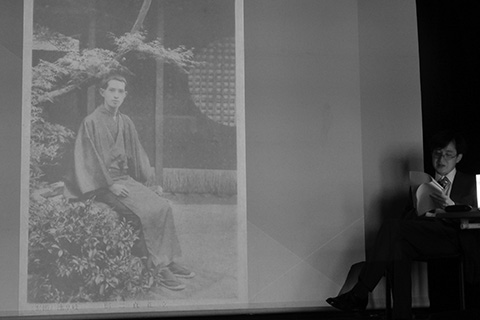
Hiroshi Komatsu showing a picture of shimpa star Teisetsu Tachibana
Tom Mes led a discussion on Japanese films of the 1990s. Readers of this website will already know that he was the right man for the job but interesting additional insights were added by Luk van Haute, who worked in the industry in the period, and Ken Okubo from Tama Art University. A crowded room heard Tom tell us that, “if the idea of the 90s as the ‘third golden age of Japanese film’ catches on, you heard it here first”. (This idea may take a while to come to fruition: as recently as 2011, I wrote, in an obituary of Hideko Tamine, that her career spanned “the golden ages” of Japanese cinema. I thought I was playing safe as to whether that was two or more golden ages, but it got axed down to one.) The presentation and discussion were supported not just by the Ishii strand but also by an interesting collection of Pia prize-winning shorts from the 90s. These were the only films at the two main venues which were not shown from a digital medium. 16mm projections are a rarity these days - there was more than a whiff of nostalgia in hearing the burr of the projector behind us, warm analogue sound in the hall, and an image nicely rounded at the corners and deftly framed with hairs.
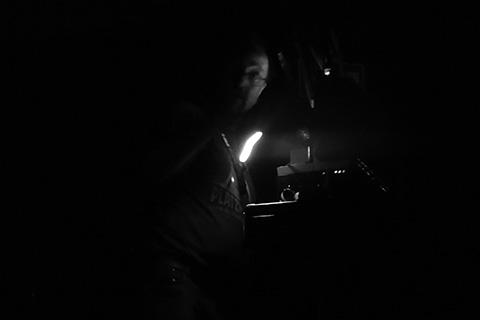
16mm projection at the Naxoshalle
There were three podium discussions with groups of filmmakers but the best-attended session seemed to be Jonathan M. Hall’s class on subtitling. A less sanguine master might have been worried to see so many able students willing to compete in a field not known to command high status in the film world, but Jonathan guided us through a lot of issues in the time he had.
But, dear reader, you may have noticed that I’ve been avoiding the films. Rest assured, most people found enough films to like, several of which I have already reviewed from Udine. With those under his belt, your Midnight Eye correspondent thought that duty beckoned to the further reaches of the ‘Nippon Visions’ strand, where new, or less established, filmmakers show their wares. For me, the best film in this strand was Dodgeball in Heat (Shakunetsu no Dojjiboru) by Tomoyuki Furumaya. This used film language and framing to tell a story with the minimum of dialogue but considerable feeling. Alas, this was one of the 90s ‘Pia Classics’, mentioned above, and therefore not in competition. The actual award went to the documentary A2, a film I did not catch, although I saw an extract shown at a forum by the director, Ian Thomas Ash, who used his own camera to document the concerns of mothers of schoolchildren near Fukushima.
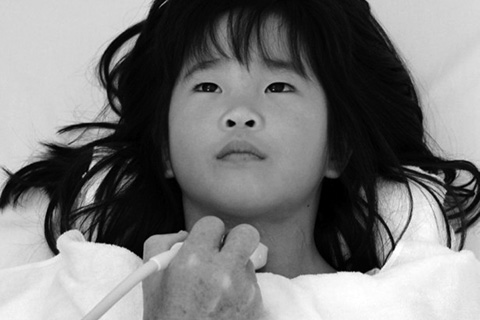
A2
Part of the problem in the ‘Visions’ strand is the introductions. If I have heard the make-up artist and a couple of actors each tell me in several languages that it’s their first visit to Germany and that they really love Frankfurt, I’m either impatient or half asleep. Sometimes the film’s director gets it and just says that there will be a Q&A afterwards and tries to sit down quickly with the microphone. That does not stop the ‘Visions’ programmer from taking back the microphone to tell us that it’s really good to have them all in Frankfurt and that they’ll be a Q&A afterwards. Films billed at 10.30pm would thus start at 11.00pm and your correspondent would have to miss the Q&A to get the last train.
Of the thirty short and long films I saw, the want of a scriptwriter was often chronic. But there were honourable exceptions.
11 by Sora Hokimoto lasts 11 minutes and 11 seconds. It had pace, structure, and a choice of music that complimented its respectful approach. It was dialogue-free and came with a visual style of strict frontality. It should be seen rather than further described by me.
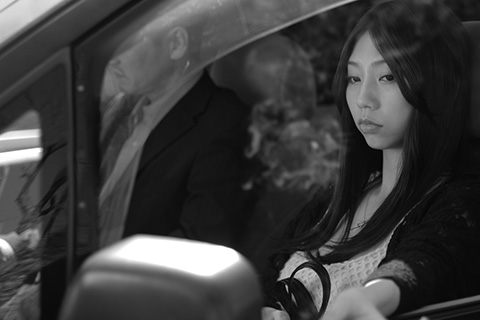
There Is Light
There is Light (Kurayami kara Te o Nobase) by Yukihiro Toda, is a nicely crafted melodrama - a rare bird these days, but rarer still for its subject - sex for the physically challenged. Actors with disabilities were by no means overshadowed by the able-bodied, and, at 68 minutes it was almost the right length, although I would have preferred if the rom-com music at the end had been cut.
This was coupled with A Case of Eggs (Keranhanpan) by Yuri Kanchiku which certainly was a rom-com although in decades past it might have been classed as soft porn. It’s set in Seoul and stars So-young Choo as a Japanese translator. It was often funny and sexy, although positioning Choo as a thirty-year old virgin was surely a male fantasy too far.
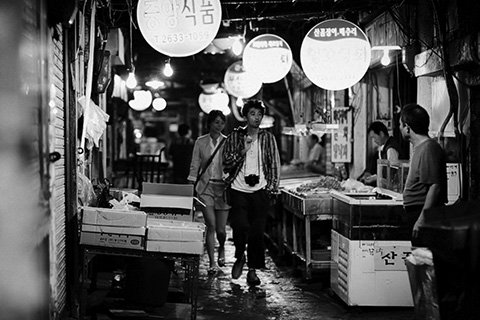
A Case of Eggs
I just wish I had been able to see these two films in the late slot. There was more than one film that, in effect, was portraying mental illness. In one in particular, some time after midnight, Frankfurt time, the subject went on meds, and the film slowed down sympathetically with her. Sudden sympathetic drowsiness prompted me to finish this next day in the media viewing room, but I wish they had been better scheduled. To me, that film has unresolvable problems of consent, and remains unnamed here.
Elsewhere, however, people were having more fun. I had left the anime strand to those better qualified but I was told that it showed strength and promise. Besides delights previously mentioned, you could also catch Thermae Romae and Land of Hope, both on my ‘best of’ list for 2012. So, for the many visitors who came for a drink and a film, there was no shortage of vibrant bars, good discussion, and films to enjoy.